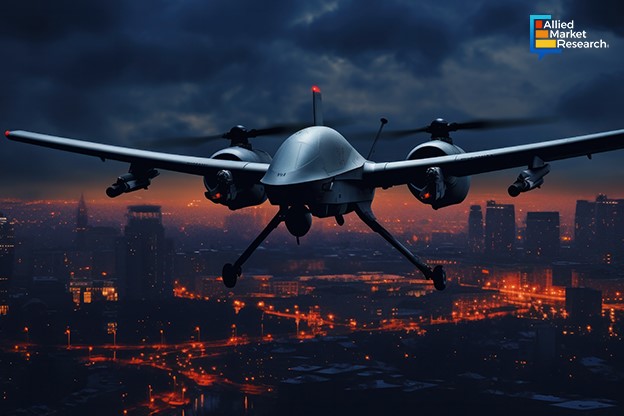Loitering Munition Systems: The New Age Drone Technology That Has Gained Popularity in Today’s Geopolitical Crises

17 May
2024
Key Takeaways:
- Introduction
- Key advantages of loitering munition systems over traditional drones
- The growth of the industry in the North America region
The post-pandemic period has been characterized by growing geopolitical tensions and major conflicts across the globe. The ongoing wars between Russia and Ukraine, Israel and Palestine, and Armenia and Azerbaijan have once again brought back the focus on military spending and the technological advancements that have taken place in the defense sector. While almost all the major countries across the globe have been increasing their military arsenal and spending over the past four to five decades, the majority of this spending is for conventional weapons and defense systems like tanks, fighter jets, aircraft carriers, assault rifles, radars, etc.
However, in the past few years, the role of unmanned aerial vehicles (UAVs) or drones in modern warfare has increased, which is why many countries are actively investing in and developing advanced drone systems that are capable of inflicting maximum damage on enemy installations and infrastructure. One such state-of-the-art drone technology is the loitering munition system which has been widely used in many of the ongoing conflicts and is expected to dominate the defense sector in the near future.
Innovations in loitering munition systems to open numerous growth opportunities for the defense sector
Loitering munition systems are drones or unmanned aerial vehicles (UAVs) that have in-built warheads fitted in them. Contrary to the popular mechanism of launching these warheads on the target, these drones loiter around till the target is locked, and then go on to crash on the target itself, thereby destroying the target and itself in the process. Due to this mode of attack, loitering munition systems are popularly called suicide drones or kamikaze drones.
The idea of suicide drones first came up in the 1980s when Israel Aerospace Industries developed the first loitering munition system called HARPY for Suppression of Enemy Air Defense (SEAD) missions. Since then, suicide or kamikaze drones have evolved massively to become the most effective weapon against high-value time-sensitive targets. As compared to traditional drones, the range of loitering munition systems is much larger. These advanced drones can engage with targets that are beyond the visual line of sight and can effectively search, identify, and attack those targets.
Also, the technologies used in suicide drones make them fully autonomous so that they can carry out all the designated activities without any human intervention. Additionally, these drones can be launched from either land, air, or sea and hence can be integrated with almost all the existing weapon launching systems such as man-portable systems, combat vehicles, warships, artillery, etc. Moreover, due to their very nature and objective, suicide drones are much cheaper than traditional drones as they are sort of single-use systems. Finally, the advanced technologies used in loitering munition systems make them hard to detect and intercept which makes their hit ratio much better than traditional drones.
The industry in the North American region to flourish immensely
As said earlier, the escalating global conflicts have increased the revenue share of the loitering munition systems industry across the globe. However, when compared on a regional basis, North America is projected to surpass all other major regions like Asia-Pacific, Europe, and LAMEA comfortably, primarily due to the massive growth rate of the industry in the US. The United States of America has the largest army in the world and spends billions of dollars every year to modernize its army.
Studies have shown that their military spending is larger than the GDPs of certain countries combined. The private defense companies operating in this region have invested heavily in R&D activities to develop state-of-the-art drone technologies. Furthermore, the US is also one of the largest exporters of arms and defense technologies which is estimated to benefit this industry in the coming period. The active support provided by the US to Ukraine and Israel has led to the US government sending arms and ammunition to these countries. The demand for advanced drone technologies is anticipated to surge in the coming period, thus helping the industry to grow.
To summarize, the growth of the loitering munition systems industry can be attributed to the critical advantages of kamikaze drones over traditional ones. Furthermore, the widespread geopolitical tensions around the world are also projected to play a huge role in the expansion of this domain.Â
For insights into how your business can capitalize on the opportunities offered by the industry, feel free to contact us.

Akhilesh Prabhugaonkar
Author's Bio- Akhilesh Prabhugaonkar holds a bachelor’s degree in Electronics Engineering from the reputed Vishwakarma Institute of Technology. He has a special interest in the fields of forensics, world history, international relations and foreign policy, sports, agriculture, astronomy, security, and oceanography. An ardent bibliophile and melophile, Akhilesh loves to write on topics of his interest and various other societal issues. This love for writing made him enter the professional world of content writing and pursue his career in this direction.
Avenue: Entire Library membership of Allied Market Research Reports at your disposal
- Avenue is an innovative subscription-based online report database.
- Avail an online access to the entire library of syndicated reports on more than 2,000 niche industries and company profiles on more than 12,000 firms across 11 domains.
- A cost-effective model tailored for entrepreneurs, investors, and students & researchers at universities.
- Request customizations, suggest new reports, and avail analyst support as per your requirements.
- Get an access to the library of reports at any time from any device and anywhere.
Related Post
-
How are Submarine Cables Transforming Global Connectivity with Enhanced User Experience?
-
Endoscopy Procedures: Transformations in Techniques and Applications
-
AI-Powered Video Analytics: How the Product Actually Works for enterprises
-
Painting Robots: Transforming Precision Coating and Creative Applications
-
Innovations in Pharmacovigilance Systems Advancing Patient Safety
-
Understanding Edge Security: Keeping Data Safe Near the Source
-
Exploring the Use and Advancements of 3D Laser Scanners in Professional Applications
-
Reinforcing Industrial Controls with Smarter Tools and Training








